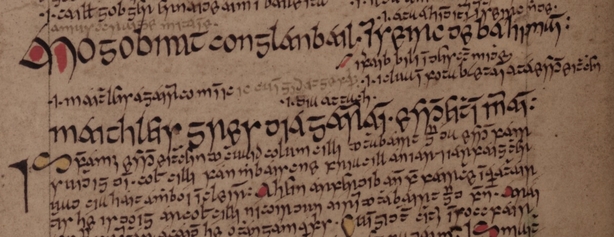Analysis: St Gobnait was an Irish female saint associated with bees in the Middle Ages and is still celebrated by local communities today
By Alison Ray, University of Oxford
St Brigid is famously celebrated as the 'Mother Saint of Ireland', but few are aware that she shares her feast month of February with another fascinating medieval religious woman, St Gobnait. Now renewed attention, including a major exhibition at the National Museum of Ireland - Country Life, is bringing focus to Ireland's lesser-known patron saint of bees and beekeeping.
Who was St Gobnait?
According to tradition, Gobnait was born in Co Clare during the 5th or 6th century and was a descendant of Conaire Mór, an ancient High King of Ireland. She is recorded in several medieval sources, including the 9th-century Félire Óengusso, a collection of saints' lives composed in Irish by monk Óengus of Tallaght.
The text lists Gobnait's feast day of February 11th, and describes her as being 'with pure goodness, as to God's love was opulent' (Mo Gopnat co n-glanbail, im sheirc Dé ba h-ilmain). She travelled throughout Ireland and was later an abbess of a women's monastic community in Ballyvourney, southwest Cork, where the legends of her bees originated.

Bodleian Library, University of Oxford. Image available under Creative Commons
Miraculous bees
Bees were an important natural resource in the Middle Ages, providing wax for candles and document seals, as well as honey for use in cooking and medicinal remedies. Gobnait and her religious house purportedly kept beehives not only for honey and wax, but also for protection against attacks from unwanted invaders.
One legend tells us that thieves raided Ballyvourney in an attempt to steal cattle, when Gobnait held a beehive in her hands and prayed for her community's safety. In answer to her prayer, bees miraculously swarmed out of the hive and attacked the thieves, chasing them away.
This miracle story inspired the renowned stained glass artist Harry Clarke, who designed a window of Gobnait for the Honan Chapel at University College Cork that was installed in 1916. A preparatory drawing of the window is currently on display as part of the Murmur of Bees exhibition that explores the influence of bees on Irish culture and the environment.
We need your consent to load this rte-player contentWe use rte-player to manage extra content that can set cookies on your device and collect data about your activity. Please review their details and accept them to load the content.Manage Preferences
From RTÉ Radio 1's CountryWide, we mark St Gobnait's feast day by meeting a number of Gobnaits to find out more about the saint and some of the traditions associated with her
Accompanied by giant bees, Gobnait is portrayed standing above a beehive and her dress even features an intricate honeycomb pattern. The bottom panel depicts the legend of the saint unleashing bees against frightened thieves.
Celebrating St Gobnait
Pilgrims venerate Gobnait annually on February 11th in Ballyvourney, as well as at sites dedicated to her on Inisheer on the Aran Islands and the cliffs of Dún Chaoin, Co. Kerry. The Ballyvourney parish church houses a 13th-century wooden effigy of Gobnait and Pope Clement VIII granted a special indulgence in 1601 to visitors to the church on the saint's feast day.
Today's pilgrims complete rounds of different stations relating to Gobnait and until recently have taken the effigy's measure with a cloth strip for protection against illnesses. The effigy has now been replicated in a 3D generated wooden print out for permanent display in the church.
We need your consent to load this rte-player contentWe use rte-player to manage extra content that can set cookies on your device and collect data about your activity. Please review their details and accept them to load the content.Manage Preferences
From RTÉ Archives, Seán Mac an tSíthigh reports for RTÉ News on St Gobnait feast day celebrations in Dún Chaoin, Co Kerry in February 2007
Similarly, pilgrims to Dún Chaoin complete rounds of Gobnait's holy well and often leave offerings to the saint, such as stones, coins, and jars of honey in honour of her attribute of bees. A stone carving of Gobnait by modern Irish sculptor and artist Cliodhna Cussen is incorporated into the inner wall of the well, and visitors touch the face and drink from the water as part of the feast day rituals. From exploring early medieval pilgrimage sites to engaging 21st-century digital technologies, communities across Ireland continue to commemorate Gobnait and her unique connection to the natural world.
Follow the RTÉ Brainstorm WhatsApp channel for all our stories and updates
Dr Alison Ray is an archivist at St Peter's College and All Souls College at University of Oxford. She specialises in the Middle Ages and has a PhD in Medieval History from University College London.
The views expressed here are those of the author and do not represent or reflect the views of RTÉ

